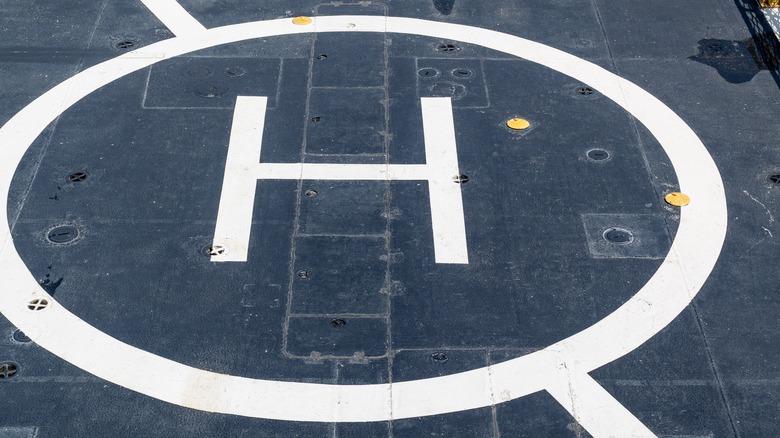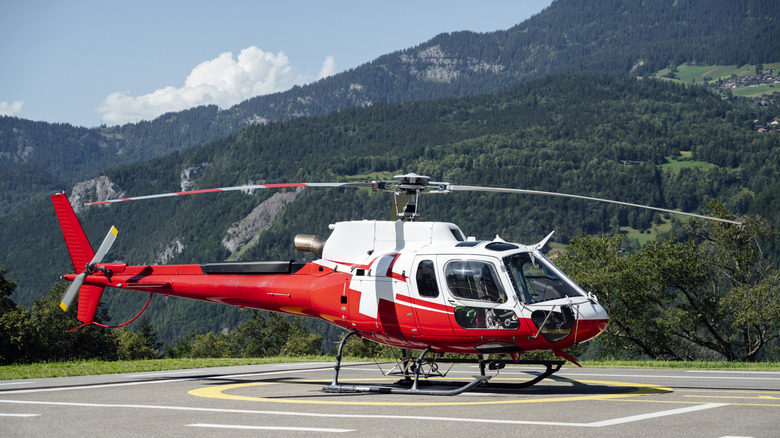Why Do Helipads Have A Giant 'H'? It's There For An Important Reason
Even if you've never flown in a helicopter, you probably still have a good idea of what a helipad looks like. If you were sketching one in Pictionary, it would probably be a simple circle with a huge letter H in the center. That is essentially all a helipad consists of. The reason for the big H is simple: Identification. A helipad is exclusively for helicopters, and would be no more suitable for the average airplane than an extended runway would for a helicopter. Though a chopper has much more freedom to land than most of its fellow aircraft, there can be great danger to those on the ground and in the helicopter if it doesn't land precisely where it should.
Any obstructions around a helipad can be fatal. The Apache helicopter even has inbuilt wire cutters to help manage such obstructions. As such, the landing area is as wide open as the surrounding terrain allows, and is often designated as clearly as possible: with a large H in the center. This allows the pilot to identify the landing zone's exact position from a distance and prepare the safest approach toward it.
In 2004, the Federal Aviation Administration [PDF] issued an advisory circular that noted, "the H should be located in the center of the TLOF [touchdown and liftoff area] and oriented on the axis of the preferred approach/departure path." The letter H, then, is a symbol that is difficult to misconstrue regardless of orientation, standing for Helicopter Landing Area according to Heliwagon.
The information that helipads provide
The letter H is a conveniently angular way to impart a lot of information and guidance at a glance. The Federal Aviation Administration [PDF] also notes "A bar may be placed under the H when it is necessary to distinguish the preferred approach/departure direction," thereby giving pilots additional context about what's needed from them. Helipad markings aren't solely designed to help guide pilots to a landing, though.
In some cases, they can also warn that a given helipad isn't designed to accommodate a particular helicopter. Numbers have to be clearly signposted to indicate helipad weight limits. The number 12, for example, means the helipad can't support more than 12,000 pounds. If this is necessary, the information will be displayed prominently, in an area inside the helipad designated for that purpose known as the "TLOF size/weight limitation 'box'." The numbering was required to be three feet tall against a contrasting backdrop, again ensuring that the message couldn't be missed. To maintain helicopter flight safety, these measures have to be taken.
It can also be important to convey size limitations and identification numbers for specific landing pads. There's no scope for making errors when it comes to aviation safety, so presenting this information in a way that's easy for pilots and crew to read (both on the ground and in the air) is an efficient way to keep helicopter travel safer. The information necessary, however, will vary depending on where that helipad is located.
The different types of helipad
Helicopters are capable of incredibly versatile landings and take-offs, rivaled only by the rather rare VTOL airplane. This means that they can be put to uses that other aircraft typically can't, such as rescue missions. The Korean War not only marked the first time the military used helicopters for medevac duty, with models such as Bell's H-13 Sioux, but it was also the first time helipads were used.
The duties of today's sophisticated helicopters take them all over the world, and that means tackling all kinds of difficult terrain and even flying in inclement weather. As a result, there are important differences between types of helipads. In June 2013, for instance, forces in India's Junglechetti region built impromptu helipads to facilitate the access of rescue helicopters to those affected by landslides and flooding in the area. Such temporary emergency measures are a world apart from permanent helipads made from metal and outfitted with lighting. Everything has to be considered, down to the color scheme.
Sometimes, a helicopter and its personnel are treated to a heliport, which is something of a service station equivalent, offering rest and supplies to replenish both aircraft and personnel. Heliports, just like helipads, are designed to meet the needs of the aircraft that use them. This is why the Vietnam War was the setting for the biggest heliport ever. According to Guinness World Records, the heliport in An Khe was large enough for 435 helicopters.


